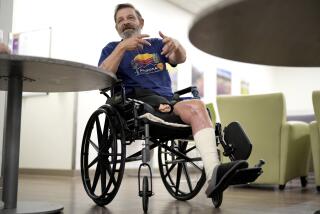‘There Are No Healthy Tans,’ Panel Insists : Parents Urged to Teach Children About the Dangers of Too Much Sunshine
- Share via
WASHINGTON — Citing the known skin cancer dangers from exposure to sunlight, a federal advisory panel Wednesday urged Americans to better protect themselves and, especially, to teach children about the sun’s perils.
Studies indicate that 50% of an individual’s total lifetime exposure to ultraviolet radiation occurs before the age of 18, the panel said. It recommended that schools, camps, day-care centers and other facilities change their schedules of outdoor activities to enable children to avoid the hours of greatest risk, which occur usually between 10 a.m. and 3 p.m.
“We are particularly concerned about children because they are most vulnerable to its long-term effects,” said Dr. David R. Bickers, chairman of the department of dermatology at Case Western Reserve University in Cleveland, who served as panel chairman.
“Reducing exposure during the early years of life may significantly reduce” the effects that appear in adulthood, such as skin cancer, sagging skin, wrinkles, leathery texture and blotchy discoloration, he said.
Staying in Shade
Dr. Lawrence A. Schachner, professor of pediatrics and dermatology at the University of Miami School of Medicine and a member of the panel, recommended that outdoor physical education programs be scheduled for early mornings and that schools and other facilities provide “shaded areas for outdoor lunches.”
“I’d like to quote Noel Coward that ‘Only mad dogs and Englishmen go out in the noonday sun,’ ” he said. “We have to learn that in childhood populations, just as with adults, it is bad advice to say, ‘This child looks pale, he needs a tan.’ There are no healthy tans.”
The committee, convened by the National Institutes of Health to study the impact of the sun’s ultraviolet radiation on the skin, also called for “more aggressive and targeted” public education programs to encourage Americans to adopt “low-risk” behaviors.
The panel, however, did not specify who should conduct such campaigns, saying only that “there may well be opportunities for many organizations,” such as medical or public health groups, in this area.
The recommendations of an NIH-convened consensus conference do not have the force of law, but are often considered an important influence on public policy.
Tanning Parlors
The committee also called for greater regulation of tanning parlors, recommending against their use “for cosmetic purposes,” and urging that all Americans increase their use of protective sunscreens, particularly those who live in Sun Belt areas.
The panel stopped short of recommending that people avoid the sun entirely.
“Tanning is potentially a hazardous practice but one has to be realistic about how people spend time and vacations,” Bickers said. “The panel recognizes that people want to go into the sun.”
But “if people want to do this,” he said, they should regularly use sunscreens.
Skin cancers due to ultraviolet radiation exposure are the most common form of cancer. They include basal cell and squamous cell carcinomas, which are usually curable, in addition to the less common but often fatal melanoma.
In 1978, there were 500,000 new cases of skin cancer, a figure the panel called “probably a gross underestimate” for 1989 “because the number of (doctor’s) office visits for non-melanoma skin cancer has increased more than 50% in the last decade while the overall increase in office visits has increased only 11%.”
The committee recommended that a sunscreen with a protective factor of 15 or higher be regularly used, even by children younger than 2. Further, it said, sunscreens should be used on a frequent and daily basis during times of the year when sun exposure is greatest, and at all times by people who live in Sun Belt areas.
The panel said combination sunscreens, which protect against both types of ultraviolet radiation, A and B, are preferable to those that protect only against ultraviolet B.
Although questions have been raised about the potential long-term health effects of sunscreens, Bickers said the panel believes that the benefits of using them outweigh any hazards.
More to Read
Sign up for Essential California
The most important California stories and recommendations in your inbox every morning.
You may occasionally receive promotional content from the Los Angeles Times.













